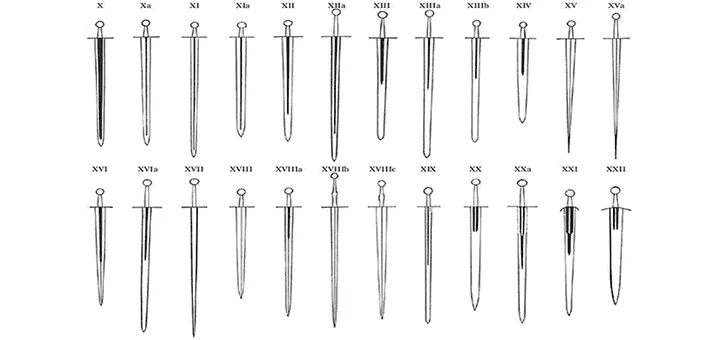
This article about the Oakeshott typology is a follow-up of my previous post about sword classification. In case you missed it check it out here.
Table of Contents
Basics
Created by the historian Ewart Oakeshott (1916-2002), his classification system is very detailed and widely used. In his work, he defined several distinguishable factors of swords. They will be covered in the next chapter.
Criteria
The most important differences between swords are the profile, grip, cross-section, average blade length and the primary purpose.
Oakeshott types
Type X
Most of these swords were used in the late Viking age (9th – 12th century).

- Profile: broad and medium length
- Grip: single-hand (9 cm/3.5 in)
- Cross-Section: lenticular
- Average Blade length: 76 cm (30 inches)
- Primary Purpose: cutting
Type XI
These swords were in use between 1100 and 1175.

- Profile: longer, narrower than Type X
- Grip: single-hand (9 cm/3.5 in)
- Cross-Section: lenticular
- Average Blade length: 95 cm (37.4 inches)
- Primary Purpose: cutting
Type XII
Common sword in the High Middle Ages (13th – 15th century). In this category are arming swords.

- Profile: broad, flat and evenly tapering
- Grip: single-hand (9 cm/3.5 in)
- Cross-Section: lenticular
- Average Blade length: 81 cm (31.9 inches)
- Primary Purpose: cutting
Type XIII
These swords were developed in the age of the Crusades (middle of the 13th century to 15th century). As they got a slightly longer grip they are considered hand-and-a-half or bastard swords.
- Profile: broad, flat and parallel edges
- Grip: hand and a half (15 cm/5.9 in)
- Cross-Section: lenticular
- Average Blade length: 88 cm (34.6 inches)
- Primary Purpose: cutting
Type XIV
This Oakeshott type features swords from the late 13th to mid 14th century.

- Profile: broad, flat and sharply tapering
- Grip: single-hand (9 cm/3.5 in)
- Cross-Section: lenticular
- Average Blade length: 76 cm (30 inches)
- Primary Purpose: cut and thrust
Type XV
These swords were used from the 14th to 15th century and are considered bastard swords.

- Profile: Straight tapering
- Grip: hand and a half (15 cm/5.9 in)
- Cross-Section: flat diamond
- Average Blade length: 79 cm (31.1 inches)
- Primary Purpose: thrusting
Type XVI
These swords were used in the early 14th century.

- Profile: broad, flat and sharply tapering
- Grip: single-hand (10 cm/3.9 in)
- Cross-Section: flat diamond
- Average Blade length: 76 cm (30 inches)
- Primary Purpose: thrusting
Type XVII
This Oakeshott type was used between the 14th to the early 15th century.

- Profile: long, slender and acutely tapering
- Grip: two-handed (20 cm/7.9 in)
- Cross-Section: hexagonal
- Average Blade length: 89 cm (35 inches)
- Primary Purpose: thrusting
Type XVIII
This classification features swords from the mid 15th century to mid 16th century.

- Profile: long, fairly broad, evenly tapers to a sharp point
- Grip: one-handed (10 cm/3.9 in)
- Cross-Section: diamond
- Average Blade length: 81 cm (31.9 inches)
- Primary Purpose: cut and thrust
Type XIX
This category includes single-handed as well as hand-and-a-half swords from the mid 15th century.
- Profile: narrow, flat
- Grip: one-handed and hand-and-a-half (10-15 cm/3.9-5.9 in)
- Cross-Section: hexagonal
- Average Blade length: 86 cm (33.9 inches)
- Primary Purpose: cut and thrust
Type XX
This Oakeshott typology category features swords from the 14th to 15th century.
- Profile: nearly parallel or only slightly tapered
- Grip: hand-and-a-half (15 cm/5.9 in)
- Cross-Section: lenticular or octagonal
- Average Blade length: 82 cm (32.3 inches)
- Primary Purpose: cut and thrust
Type XXI
This category contains swords from the late 15th century.
- Profile: broad heavily tapering swords
- Grip: one-handed (9 cm/3.5 in)
- Cross-Section: hexagonal
- Average Blade length: 76 cm (30 inches)
- Primary Purpose: cut and thrust
Type XXII
This is the last Oakeshott typology class, which includes swords from the mid 15th to 16th century.
- Profile: broad, flat blade, moderate tapering
- Grip: one-handed (9 cm/3.5 in)
- Cross-Section: hexagonal
- Average Blade length: 76 cm (30 inches)
- Primary Purpose: cut and thrust